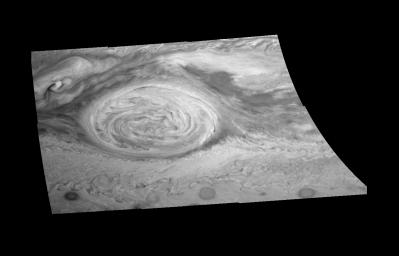
|
Great Red Spot Mosaic - Near-infrared Filter
- Click the image above for a larger view
- Full-Res JPEG (1400 x 900) (76.3 kB)
- Full-Res TIFF (1400 x 900) (506.6 kB)
Caption:
Great Red Spot (GRS) of Jupiter as seen through the near-infrared (757 nm) filter of the Galileo imaging system. The image is a mosaic of six images taken over an 80 second interval during the first GRS observing sequence on June 26, 1996. They have been map-projected to a uniform grid of latitude and longitude. North is at the top. The Red Spot, which is 20,000 km long, has been followed by observers on Earth since the telescope was invented 300 years ago. It is a huge storm made visible by variations in the composition of the cloud particles. Counterclockwise winds around its periphery reach 100 m/s. The Red Spot is not unique, but is simply the largest of a class of long-lived vortices, such as the three smaller vortices visible to the south. Other features of interest include a very bright cloud feature to the northwest and the dark collar surrounding the Great Red Spot.
Background Info:
Launched in October 1989, Galileo entered orbit around Jupiter on December 7, 1995. The spacecraft's mission is to conduct detailed studies of the giant planet, its largest moons and the Jovian magnetic environment. The Jet Propulsion Laboratory, Pasadena, CA manages the mission for NASA's Office of Space Science, Washington, DC.
This image and other images and data received from Galileo are posted on the World Wide Web, on the Galileo mission home page at http://galileo.jpl.nasa.gov. Background information and educational context for the images can be found at http://www.jpl.nasa.gov/galileo/sepo .
Cataloging Keywords:
| Name | Value | Additional Values |
|---|---|---|
| Target | Jupiter | |
| System | Jupiter | |
| Target Type | Planet | |
| Mission | Galileo | |
| Instrument Host | Galileo Orbiter | |
| Host Type | Orbiter | |
| Instrument | Solid-State Imaging (SSI) | |
| Detector | ||
| Extra Keywords | Atmosphere, Grayscale, Infrared, Magnetosphere, Map, Storm | |
| Acquisition Date | ||
| Release Date | 1997-09-07 | |
| Date in Caption | 1996-06-26 | |
| Image Credit | NASA/JPL-Caltech | |
| Source | photojournal.jpl.nasa.gov/catalog/PIA00488 | |
| Identifier | PIA00488 | |
